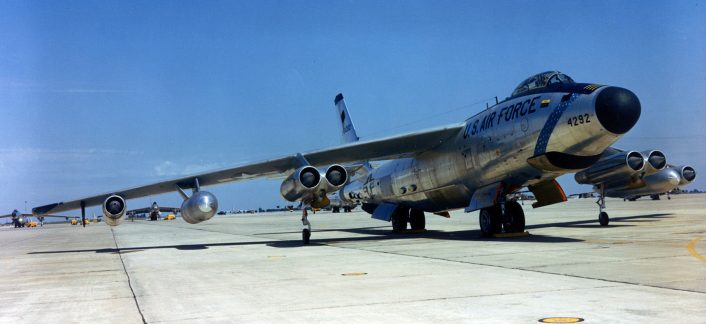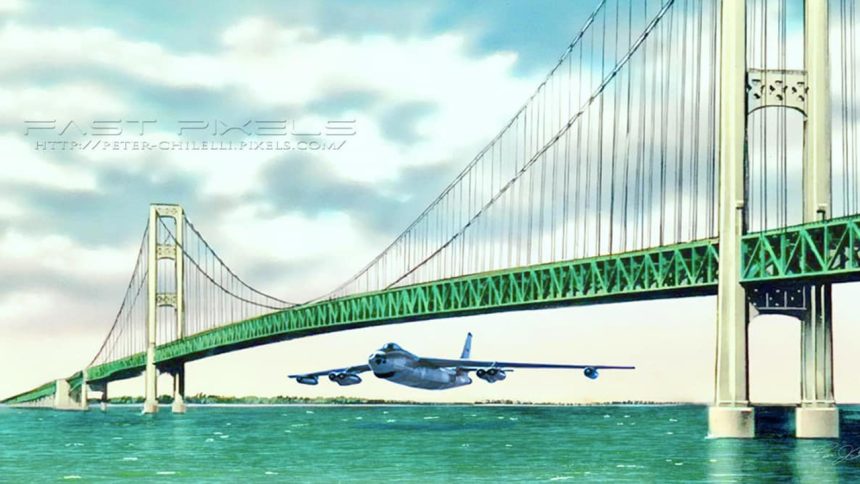Bomber Bridge Buzz Tops Maverick’s Tower Blast By A Bunch- But Is It Baloney?
We’ve all seen the fictional tower buzz scene from Top Gun. And, of course, nothing like that could ever happen in real life. Or could it?
65 years ago today on April 24, 1959, legend has it that an aviation stunt so bizarre it defies belief actually took place in the Mackinaw Straits between the upper and lower peninsulas of Michigan.
A U.S. Air Force RB-47E Stratojet reconnaissance aircraft piloted by Strategic Air Command pilot Capt. John Stanley Lappo was said to have flown underneath the Mackinaw Bridge where Lake Michigan and Lake Huron converge. As history records the event, no photos of the aircraft flying under the bridge exist, but the stunt, if it actually did happen, created enough buzz that a legend was born.
According to the thisdayinaviation.com website and the Wikipedia page for the Mackinaw Bridge, fitting a Boeing RB-47E Stratojet under the Mighty Mac was a tight squeeze with little margin for error. The highest place between the water surface in the Mackinaw Strait and the bottom of the Mackinaw Bridge is 155-feet at the center. The tail of an RB-47E stands 27-feet, 11 inches off the ground. If you do the math, that leaves about 127-feet of space between the water and the bottom of the bridge to play with. Considering the RB-47E stall speed in these conditions may have been as slow as 150-190 MPH, the plane would cover that distance in altitude in just over a second or two.
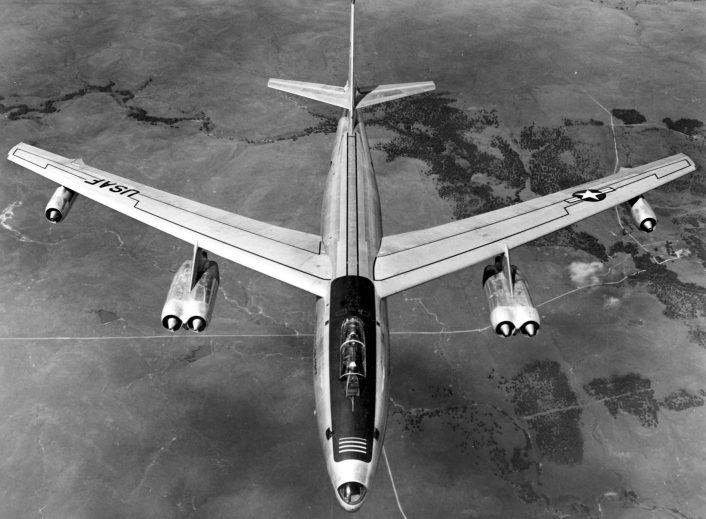
As the story goes, and is told in several media outlets, Capt. Lappo was, “Reported by his navigator” to some higher authority after the bridge fly-under. The legend claims that Lappo was, “charged with violating a regulation prohibiting flying an aircraft below 500-feet”. No great aviation tale is complete without details, and the story is that Capt. Lappo was permanently removed from flight status by the Commanding General of the Eight Air Force, Lieutenant General Walter Campbell.
The deeper you get into the story of the RB-47E bridge fly-under, the more believable it seems to become. Apparently, Capt. Lappo had served as a reconnaissance pilot in classified intelligence gathering flights on the other side of the Iron Curtain at the height of the Cold War. After his alleged bridge stunt, Capt. Lappo did stay in the U.S. Air Force. He even is said to go on to become the vice commander of Alaska’s Elmendorf Air Force Base. He eventually became a lieutenant colonel.
Can we believe the story of Capt. Lappo and the Mackinaw Bridge fly-under? It’s difficult to say. An in-depth Freedom of Information Act inquiry may produce records of any military disciplinary actions as a result of Lappo’s impromptu airshow. But as far as media results go, there is mention of an October 17, 1976 news story in the Free Press, a Detroit, Michigan newspaper. We could not locate that story with an internet search of the Free Press archives or through conventional search engines.
One story in the Free Press does feature an image of an August 26, 1959 story with the headline, “AF Captain Punished: Flies Jet Bomber Under ‘Mac’ Bridge”.
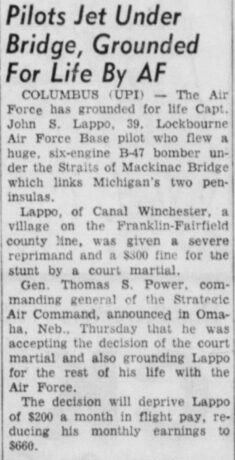
Most stories about the alleged fly-under appear on the internet after 2019. Before that, there is no verifiable report of the incident. Given these results, all the features of an urban legend exist here. This is not to say the story is impossible. In fact, this writer has flown under San Francisco’s Oakland Bay Bridge in a Bell Jet Ranger helicopter, apparently a fairly regular happening at that bridge.
Additionally, the U.S. Coast Guard and the Michigan State Police captured video of a small single engine light aircraft flying under the Mackinaw Bridge on June 28, 2020. The video of the claimed event has been posted to YouTube by WOOD TV8 and shared by credible media outlets like the Kansas City Star. This event appears authentic, but the legend of the B-47 flying under the bridge seems to proliferate in the immediate aftermath of the June 28, 2020 light aircraft fly-under. Is that more than coincidence?
When The Aviationist asked Michigan historian and director of the Selfridge Military Air Museum at Selfridge Air National Guard Base in Michigan, Steve Mrozek, if he thought the story of the B-47 bridge fly-under is credible, he said, “No. I’ve never heard of it. We had P-39s flying under the Ambassador Bridge, but this sounds pretty far-fetched.”
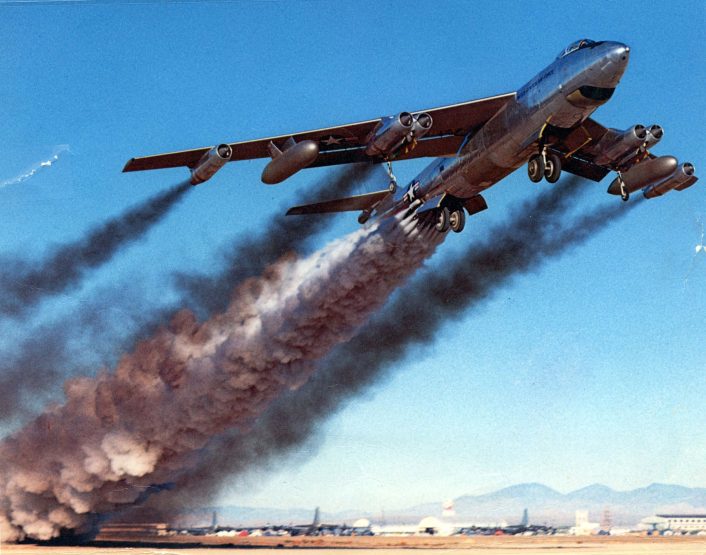
The RB-47 Stratojet
Developed as a variant of the renowned Boeing B-47 Stratojet bomber, the RB-47 was specially equipped and adapted for reconnaissance operations, providing invaluable intelligence on potential adversaries.
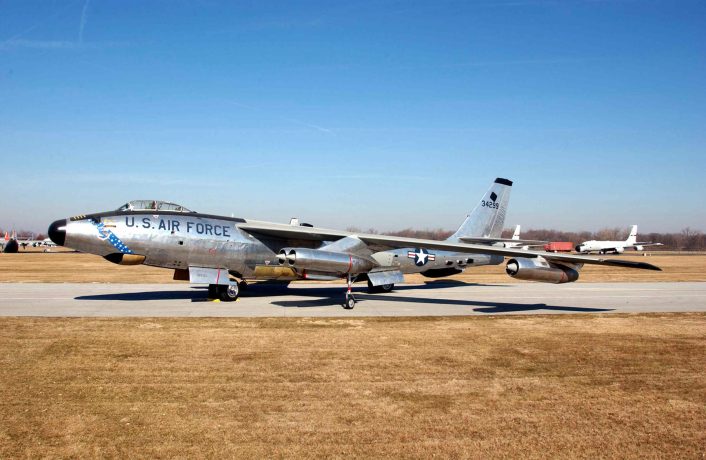
Both the RB-47E and RB-47H were variants of the Boeing B-47 Stratojet, a strategic bomber used by the United States Air Force during the Cold War. While they shared the same basic airframe, there were some key differences between the RB-47E and RB-47H:
- Purpose:
- RB-47E: The RB-47E was primarily used for photographic reconnaissance missions. It was equipped with cameras and other intelligence-gathering equipment to collect imagery of enemy territory for analysis.
- RB-47H: The RB-47H, on the other hand, was an electronic intelligence (ELINT) variant. Its main mission was to gather signals intelligence (SIGINT) by intercepting and analyzing electronic emissions from potential adversaries.
- Equipment:
- RB-47E: The RB-47E was equipped with cameras and photographic equipment for capturing images of enemy territory. It also had some basic electronic countermeasures (ECM) equipment for self-defense.
- RB-47H: The RB-47H was outfitted with sophisticated electronic intelligence-gathering equipment, including receivers and antennas, to intercept and analyze enemy electronic signals. It lacked the photographic equipment found on the RB-47E.
- Crew Composition:
- RB-47E: The RB-47E typically had a crew of six members, including pilots, navigators, and camera operators.
- RB-47H: The RB-47H also had a crew of six, but its crew composition was specialized for electronic intelligence missions, with personnel trained in SIGINT collection and analysis.
- Mission Profile:
- RB-47E: The RB-47E would fly over enemy territory to capture photographic imagery, often operating at high altitudes and high speeds to avoid enemy defenses.
- RB-47H: The RB-47H would conduct electronic intelligence-gathering missions, flying near or within enemy airspace to intercept and analyze electronic signals emitted by radar systems, communications networks, and other sources.
Overall, while both the RB-47E and RB-47H were variants of the B-47 Stratojet used for intelligence missions, they had distinct roles and equipment tailored to their specific reconnaissance and intelligence-gathering tasks.
